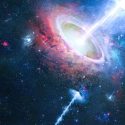A rogue star is headed straight for our Sun. If these two stars slam into each other, it could spell the end of all life on our planet. How could a rogue star end up in our Solar System? What would this epic collision look like? And how much time do you have left to live?
As the name would suggest, rogue stars drift through space. They don’t belong to any particular galaxy. Or if they once did, they’ve been ejected from their homes at some point by supernovas or two galaxies ramming into each other. Whatever it is that sends these stars hurtling away from the gravitational pull of their original galaxies, it fires them off at very high speeds.
In order to break free of our own Milky Way galaxy, a star would need to move as fast as 550 km/s (340 mi/s). Luckily, our Sun is only moving at a mere 200 km/s (124 mi/s). Not nearly fast enough to become rogue. But these wandering stars aren’t all that uncommon. They may even account for as many as half of the 200 billion trillion stars in the Universe. And one of them could be headed toward our Sun right now.
Meet Gliese 710. This rogue dwarf star is on a trajectory that would bring it close to our Solar System in around 1.3 million years. When Gliese 710 eventually reaches us, it would enter the outermost section of our Solar System, the Oort Cloud, at a speed of about 51,500 km/h (32,000 mph). It could send the icy bodies out there flying in different directions.
Maybe even right toward Earth. Once it has reached Neptune, the countdown to the epic collision would begin. T-minus 10 years till the impact with the Sun. At this point, you’d better plan to just live your best life while prepping for the upcoming apocalypse. The gravitational pull of Gliese 710 would destabilize the orbits of our planetary neighbors, nudging them left and right.
This could go as far as pushing Earth out of the habitable zone. Or it could turn us into a rogue planet after unceremoniously being catapulted out of the Solar System. After 10 years, it would finally be getting close to collision time. As each day passes, things are only going to get worse. One possibility is that the Sun and Gliese 710 would merge into a red nova.
This would result in a violent explosion that would unleash nearly half a million times more light than what the Sun does right now. Given the amount of time light takes to travel from the Sun to the Earth, you would be blissfully unaware of this destructive explosion for eight minutes. But the moment you do find out, all that light would likely blind you in a millisecond and then immediately fry you on the spot.
That’s because directly behind this blinding light would be super hot gas. This wave of heat could be powerful enough to wipe out nearly everything in its path. Bye-bye Mercury, Venus and, yep, Earth. too. Our atmosphere and oceans would be completely blasted away. This would leave our planet as nothing more than a barren rock.
The explosion would also have created massive amounts of high energetic neutrinos. These would be able to boil you from the inside out. Earth would also be shrouded in lethal levels of UV and gamma radiation. Even if you somehow managed to survive the explosion, you wouldn’t last long from the harmful effects of all this radiation. You’d have damage to your eyes, skin and even DNA.
If an alien species was watching this all unfold from a distant galaxy with an incredibly powerful telescope, they’d see a single bright star surrounded by an excess of reddish-colored gas. And the infrared light left behind from the explosion would be visible for a long time after. But that wouldn’t be the only way all this could possibly go down. There’s a possibility there could be a more peaceful alternative.
Yeah, if the two stars are moving a bit slower relative to each other, they could end up merging into one massive new star as they orbit each other. Our Sun would strip mass from its smaller companion, Gliese 710, and swallow it in a process known as stellar cannibalism. This extremely hot and bright star would be called a blue straggler.
Though it may sound many times more peaceful, this option could still likely spell out the end of life on Earth. With our Sun now a massive blue star, the habitable zone of our Solar System would be pushed further away. What else would happen if our Sun became a blue star?
Sources
- “Rogue Stars Outside Galaxies May Be Everywhere”. Daniel Clery. 2014. science.org.
- “Determination Of The Escape Velocity Of The Milky Way Using A Halo Sample Selected Based On Proper Motion”. Koppelman, Helmer H., and Amina Helmi. 2021. Astronomy &Amp; Astrophysics 649: A136. doi:10.1051/0004-6361/202038777. arxiv.org.
- “How Fast Is Earth Moving?”. Elizabeth Howell, Doris Elin Urrutia. 2022. space.com.
- “A Rogue Star Hurtling Towards The Solar System Is Going To Arrive Sooner Than We Realised”. Michelle Starr. 2018. sciencealert.com.
- “NASA – Escape Velocity: Fun And Games “. 2022. nasa.gov.



























